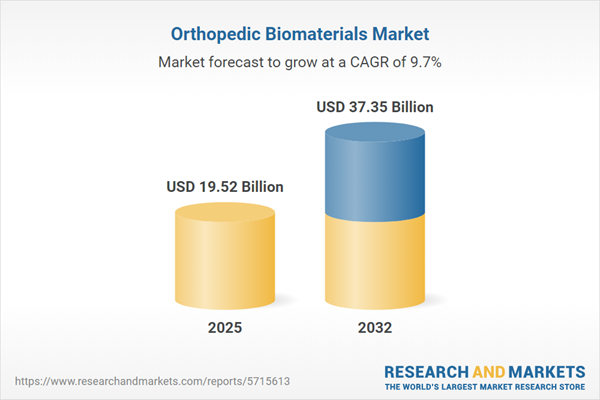Speak directly to the analyst to clarify any post sales queries you may have.
The orthopedic biomaterials market is undergoing rapid change, driven by advances in biomaterial science and digital surgical solutions. As operational and regulatory expectations evolve, senior decision-makers must navigate new procurement challenges, ensure efficiency, and capitalize on shifting industry priorities.
Market Snapshot: Orthopedic Biomaterials Market Overview
The orthopedic biomaterials market reached USD 17.79 billion in 2024 and is expected to grow to USD 19.52 billion by 2025, with long-term projections indicating expansion to USD 37.35 billion by 2032. This outlook is supported by a compound annual growth rate of 9.71%. Demographic changes, such as an aging population and increasing rates of musculoskeletal disorders globally, are fueling demand. The rapid adoption of advanced biomaterials is enhancing patient outcomes, influencing how organizations manage supplier networks, and requiring updated compliance and procurement strategies to keep pace with sector transformation.
Scope & Segmentation of the Orthopedic Biomaterials Market
- Material Types: Ceramics, including alumina, hydroxyapatite, tricalcium phosphate, and zirconia, address specific surgical requirements for strength and biocompatibility. Composites such as carbon fiber and glass fiber offer favorable mechanical characteristics for orthopedic implants. Metallic alloys—including cobalt chrome, stainless steel, and titanium—are valued for durability and integration. High-performance polymers, like polyether ether ketone, polylactic acid, and ultra high molecular weight polyethylene, are assessed for application-specific performance in diverse clinical settings.
- Applications: Orthopedic biomaterials are used in bone grafting, dental implants, joint replacements (hip, knee, elbow, shoulder), spinal fusion, sports medicine, and trauma fixation. This encompasses devices such as plates, screws, pins, and external fixators, each suitable for targeted therapeutic needs and varying patient populations.
- End Users: Ambulatory surgical centers, hospitals, orthopedic clinics, and research institutions represent key stakeholders. Each brings distinct buying preferences, usage patterns, and levels of procedural complexity, requiring suppliers to adapt offerings according to end user requirements and procurement sophistication.
- Technologies: Additive manufacturing is enabling custom-fit implants. Cell-based therapies enhance tissue regeneration. Mechanisms for targeted growth factor delivery are contributing to improved recovery. Nanotechnology is optimizing both efficacy and integration at the site of care.
- Regions: Market activity spans the Americas, Europe, Middle East and Africa, and Asia-Pacific. Each region is shaped by healthcare infrastructure capabilities, reimbursement practices, and evolving regulatory conditions, producing varied commercial opportunities and challenges for strategic planning.
Key Takeaways for Senior Decision-Makers
- Advanced manufacturing, including 3D printing and nanotechnology, improves procedural accuracy and flexibility, supporting patient-tailored solutions and more efficient workflows.
- Localization in production, influenced by regulatory and policy shifts, requires organizations to adapt sourcing strategies for faster device access in regional markets.
- Enhanced collaboration between device manufacturers, biotech firms, and research entities is catalyzing innovation cycles and evidence development, assisting faster and safer market introduction of novel products.
- Diversification of biomaterial and device options enables providers to treat complex injuries and leverage bioresorbable solutions designed for recovery and long-term health outcomes.
- Procurement models are evolving toward more flexible sourcing and robust risk management, enabling organizations to maintain reliable supply despite global and regulatory uncertainties.
Tariff Impact and Strategic Supply Chain Response
Rising tariffs on imported orthopedic biomaterials in the United States have increased manufacturing input costs. Companies are responding by focusing on domestic manufacturing and renegotiating contracts with overseas partners. These adjustments promote better value-chain alignment and underpin procurement strategies devoted to reducing risks associated with regulatory or market shifts, while sustaining consistent product availability.
Methodology & Data Sources
This report draws from direct interviews with clinicians, materials scientists, and key regulators. The analysis is enhanced by comprehensive reviews of scientific literature, industry data, and regulatory documentation. SWOT and PESTEL frameworks were employed to ensure actionable insights for senior leaders.
Why This Report Matters
- Enables organizations to align investment and sourcing strategies by identifying crucial changes in technology, regulation, and the orthopedic biomaterials market.
- Delivers granular segment and regional detail, equipping decision-makers to manage supply chains and product portfolios more effectively.
- Supports identification and mitigation of operational and regulatory risks, helping organizations to strengthen resilience in procurement and distribution.
Conclusion
Ongoing advancements in orthopedic biomaterials and adaptive regulatory conditions present both opportunities and strategic challenges. Leaders with decisive market insight can secure growth and organizational stability in a fast-evolving musculoskeletal landscape.
Additional Product Information:
- Purchase of this report includes 1 year online access with quarterly updates.
- This report can be updated on request. Please contact our Customer Experience team using the Ask a Question widget on our website.
Table of Contents
3. Executive Summary
4. Market Overview
7. Cumulative Impact of Artificial Intelligence 2025
List of Figures
Samples

LOADING...
Companies Mentioned
The key companies profiled in this Orthopedic Biomaterials market report include:- Johnson & Johnson
- Stryker Corporation
- Zimmer Biomet Holdings, Inc.
- Smith & Nephew plc
- Medtronic plc
- NuVasive, Inc.
- Globus Medical, Inc.
- Orthofix Medical Inc.
- SeaSpine Holdings Corporation
- Anika Therapeutics, Inc.
Table Information
| Report Attribute | Details |
|---|---|
| No. of Pages | 196 |
| Published | October 2025 |
| Forecast Period | 2025 - 2032 |
| Estimated Market Value ( USD | $ 19.52 Billion |
| Forecasted Market Value ( USD | $ 37.35 Billion |
| Compound Annual Growth Rate | 9.7% |
| Regions Covered | Global |
| No. of Companies Mentioned | 11 |









